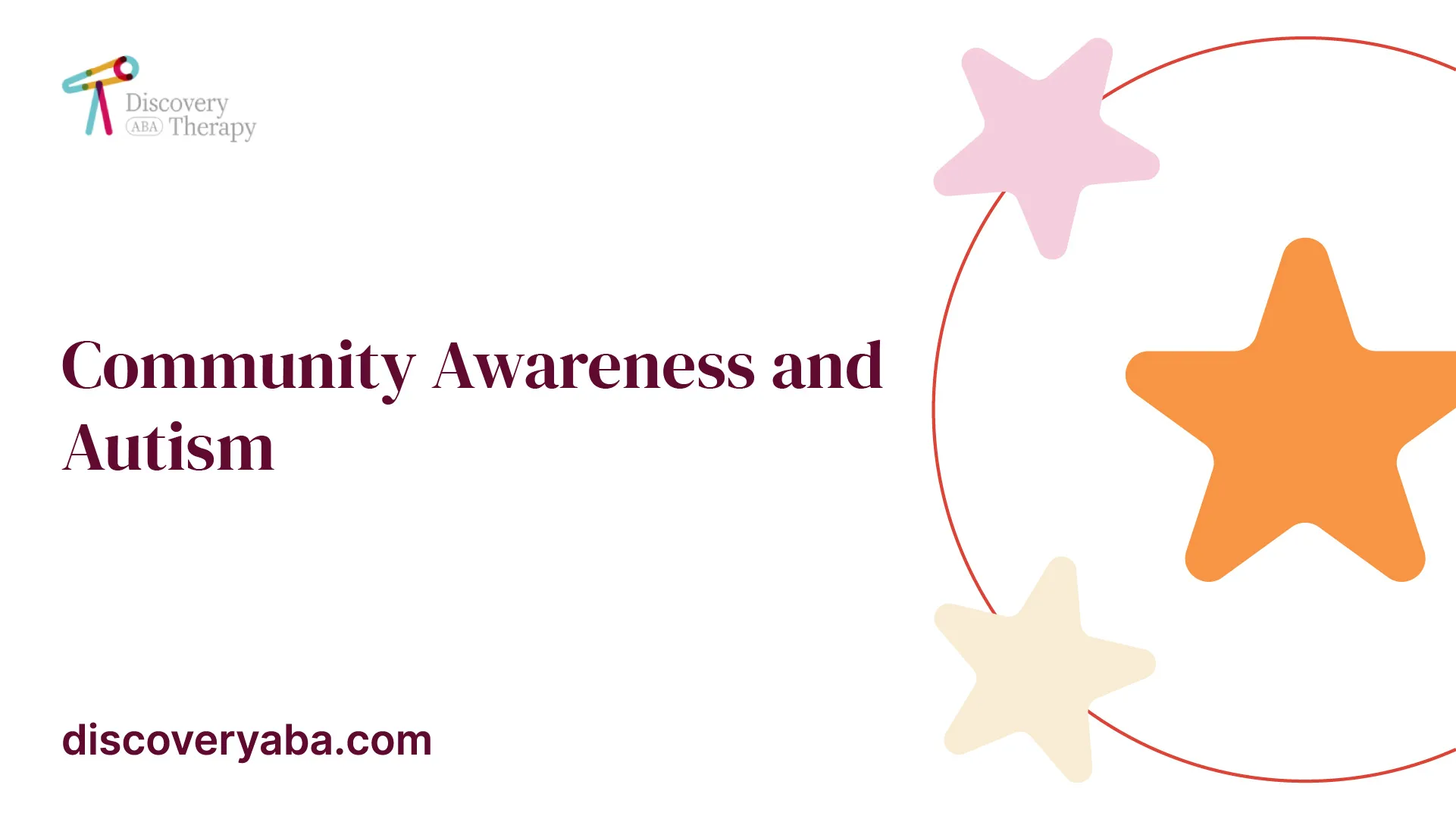Community Awareness and Autism
For individuals with autism, navigating social situations and daily life can be challenging. That's why it's important for communities to be aware of autism and how they can support individuals with autism.
%2520(1).jpeg)
Understanding Autism Spectrum Disorder
To enhance our understanding of Autism Spectrum Disorder (ASD), it is essential to explore its definition and the concept of the autism spectrum.
What is Autism Spectrum Disorder?
Autism Spectrum Disorder is a neurodevelopmental disorder that affects an individual's social communication and interaction skills. It is characterized by a range of challenges in social interaction, communication, and restricted and repetitive behaviors. The onset of symptoms typically occurs in early childhood and can persist throughout a person's life.
Individuals with ASD may experience difficulties in various areas, including social communication, sensory processing, and behavior. These challenges can vary widely from person to person, leading to a diverse range of abilities and needs within the autism community.
The Spectrum of Autism
Autism is often referred to as a spectrum disorder because it encompasses a broad range of presentations and severities. The autism spectrum acknowledges that individuals with ASD can exhibit a wide array of strengths, challenges, and characteristics.
The spectrum encompasses various profiles, each with its unique features and levels of support required. It includes individuals who may require significant support in their daily lives, as well as those who are highly independent and exhibit exceptional abilities in specific areas.
Understanding the spectrum means recognizing that every person with autism is unique and may experience a combination of strengths and challenges. Some individuals may excel in areas such as mathematics, music, or visual thinking, while others may have exceptional attention to detail or heightened sensory perception.
The concept of the spectrum allows us to appreciate the diversity within the autism community and recognize the importance of individualized support and interventions tailored to each person's specific needs.
By understanding what Autism Spectrum Disorder is and the range of characteristics it encompasses, we can foster greater awareness, acceptance, and support for individuals with autism and their families. Together, we can work toward creating a more inclusive society that embraces and celebrates the unique abilities and perspectives of individuals on the autism spectrum.

The Importance of Community Awareness
Community awareness is crucial for individuals with autism and their families. When community members understand autism, they can provide support and accommodations that make a significant difference in the lives of individuals with autism. It's essential to educate people about autism to reduce the stigma and create a more inclusive society.
One way to increase community awareness is by hosting workshops and seminars that help people understand autism. These workshops can cover topics such as autism signs and symptoms, communication strategies, and sensory issues. Another way is to organize community events that promote autism awareness. These events can include walks, runs, and other fundraisers that support autism research and advocacy.
Businesses can also play a role in creating a more autism-friendly community. For example, a grocery store may offer sensory-friendly shopping hours with dimmed lights and reduced noise for individuals with autism who may be sensitive to sensory stimuli. A restaurant may offer picture menus or allow individuals with autism to order first to reduce anxiety and improve communication. These small accommodations can make a big difference in the lives of individuals with autism and their families.
Families with autism also need support and resources. Support groups, online forums, and social media groups can provide a sense of community and a space to share experiences and advice. There are also many online resources available, such as the Autism Society and the Autism Speaks websites, which provide information on autism research, advocacy, and support.
Common Characteristics of Autism Spectrum Disorder
Autism Spectrum Disorder (ASD) is characterized by a range of common features that individuals with ASD may experience. Understanding these characteristics is essential for promoting awareness and creating a supportive environment. The three primary characteristics of ASD are social communication challenges, restricted and repetitive behaviors, and sensory sensitivities.
Social Communication Challenges
One of the hallmark features of ASD is the presence of social communication challenges. Individuals with ASD may struggle with various aspects of social interaction, such as:
- Difficulty understanding and using nonverbal cues, such as facial expressions, gestures, and body language.
- Challenges with maintaining eye contact during conversations.
- Delayed or atypical development of spoken language, such as delayed speech or echolalia (repeating words or phrases).
- Difficulty engaging in reciprocal conversations, taking turns, and understanding social nuances.
- Limited understanding of social rules and expectations, making it challenging to initiate and maintain friendships.
It is important to note that the degree and nature of social communication challenges can vary among individuals with ASD. Some individuals may have more noticeable difficulties, while others may demonstrate more subtle challenges.
Restricted and Repetitive Behaviors
Another characteristic of ASD is the presence of restricted and repetitive behaviors. These behaviors can manifest in various ways, including:
- Engaging in repetitive movements or actions, such as hand flapping, rocking, or spinning.
- Adherence to strict routines or rituals and resistance to changes in their environment or daily activities.
- Highly focused interests in specific topics or objects, often at the expense of other activities.
- Repetitive use of language, such as repetitive phrases or idiosyncratic speech patterns.
- Sensitivity to changes in sensory input, including heightened or reduced sensitivity to sounds, textures, smells, tastes, or visual stimuli.
These restricted and repetitive behaviors can serve as a way for individuals with ASD to cope with their environment and manage anxiety or uncertainty.
Sensory Sensitivities
Sensory sensitivities are a common characteristic of ASD. Individuals with ASD may have heightened or reduced sensitivity to sensory stimuli, which can affect their daily experiences. Some examples of sensory sensitivities include:
- Overwhelm or discomfort in response to loud noises, bright lights, or crowded spaces.
- Hypersensitivity or hyposensitivity to certain textures or materials, leading to aversion or seeking out specific tactile experiences.
- Heightened sensitivity to certain smells or tastes, resulting in avoidance or strong reactions.
- Difficulty filtering and processing sensory information, leading to sensory overload or withdrawal.
Understanding and accommodating sensory sensitivities is crucial in creating an inclusive and supportive environment for individuals with ASD.
By recognizing and understanding these common characteristics of ASD, we can foster a more inclusive society that promotes acceptance and support for individuals with autism. It is important to remember that each person with ASD is unique, and the manifestation of these characteristics can vary. By embracing diversity and providing appropriate support, we can enhance the quality of life for individuals with ASD and their families.
Types of Autism Spectrum Disorder
Autism Spectrum Disorder (ASD) encompasses a range of conditions that affect individuals in unique ways. Understanding the different types of ASD can help in recognizing and supporting individuals with this disorder. The three main types of ASD are Autism, Asperger's Syndrome, and Pervasive Developmental Disorder-Not Otherwise Specified (PDD-NOS).
Autism
Autism is the most well-known type of ASD. People with Autism often experience challenges in social interaction, communication, and exhibit restricted and repetitive behaviors. This type of ASD is typically diagnosed in early childhood, and symptoms can vary widely in severity. Some individuals with Autism may have significant intellectual and language impairments, while others may have average or above-average intelligence. Early intervention and therapy can greatly improve outcomes for individuals with Autism.
Asperger's Syndrome
Asperger's Syndrome, previously considered a separate diagnosis but now classified under ASD, is characterized by difficulties in social interaction and communication skills. Individuals with Asperger's Syndrome often have average or above-average intelligence and may excel in specific areas of interest.
While they may struggle with social cues and understanding nonverbal communication, they can often communicate effectively through verbal means. People with Asperger's Syndrome may have intense focus or strong interests in specific subjects, often displaying extensive knowledge in those areas.
Pervasive Developmental Disorder-Not Otherwise Specified (PDD-NOS)
Pervasive Developmental Disorder-Not Otherwise Specified (PDD-NOS) is a diagnosis given when an individual exhibits some, but not all, of the classic symptoms of Autism or Asperger's Syndrome.
PDD-NOS is often used when symptoms do not fit into strict diagnostic criteria but still indicate significant challenges in social communication and interaction. Each person with PDD-NOS presents a unique combination of characteristics and may require individualized support and intervention.
Understanding the different types of ASD is crucial in providing appropriate support and interventions for individuals on the autism spectrum. It's important to remember that each person with ASD is unique, and their strengths and challenges may vary greatly. By promoting awareness, acceptance, and inclusion, we can create a more inclusive society for individuals with ASD.
Diagnosing Autism Spectrum Disorder
Diagnosing autism spectrum disorder (ASD) involves a comprehensive evaluation process. Early identification and intervention are crucial for individuals with ASD, as it allows for the development of tailored support strategies. In this section, we will explore the different aspects of diagnosing ASD, including early signs and screening, the diagnostic process, and multidisciplinary evaluation.
Early Signs and Screening
Recognizing the early signs of ASD is key to ensuring timely intervention and support. While each individual with ASD is unique, there are common behaviors and characteristics that may indicate the presence of ASD. These early signs can manifest in areas such as social interaction, communication, and behavior.
Screening tools and assessments are used to identify individuals who may be at risk for ASD. These tools are designed to evaluate a child's developmental milestones and behavior patterns. Examples of commonly used screening tools include the Modified Checklist for Autism in Toddlers (M-CHAT) and the Autism Diagnostic Observation Schedule (ADOS).
If you notice any potential signs of ASD in your child, it is important to consult with a healthcare professional or pediatrician for further evaluation. Early intervention can make a significant difference in the long-term outcomes for individuals with ASD.
Diagnostic Process
The diagnostic process for ASD involves a comprehensive assessment conducted by a team of professionals, including psychologists, pediatricians, speech-language pathologists, and occupational therapists, among others. This multidisciplinary approach ensures a thorough evaluation of the individual's strengths, challenges, and developmental history.
During the diagnostic process, the professionals will gather information from various sources, such as interviews with parents or caregivers, observations of the individual's behavior, and standardized assessments. The objective is to assess the individual's social communication skills, behavior patterns, and sensory sensitivities.
It is important to note that diagnosing ASD can be a complex and time-consuming process. The team of professionals will consider the individual's behavior across different settings and contexts to arrive at an accurate diagnosis. Patience and collaboration with the professionals involved are essential during this process.
Multidisciplinary Evaluation
The multidisciplinary evaluation is a crucial component of the diagnostic process for ASD. This evaluation involves professionals from different disciplines working together to gather information and provide a comprehensive understanding of the individual's strengths and challenges.
The professionals involved in the multidisciplinary evaluation may include psychologists, speech-language pathologists, occupational therapists, and behavioral analysts. Each professional will contribute their expertise to assess different aspects of the individual's functioning, such as cognitive abilities, language skills, sensory sensitivities, and social interactions.
The multidisciplinary evaluation aims to provide a comprehensive profile of the individual's strengths and challenges, helping to inform the development of appropriate interventions and support strategies. The collaboration between professionals ensures a holistic understanding of the individual's needs and promotes a tailored approach to intervention.
By understanding the process of diagnosing ASD, including early signs and screening, the diagnostic process, and multidisciplinary evaluation, parents and caregivers can navigate the journey with greater awareness and knowledge. Seeking professional guidance and support is crucial in ensuring that individuals with ASD receive the necessary interventions and resources to thrive.
Supporting Individuals with Autism Spectrum Disorder
When it comes to supporting individuals with Autism Spectrum Disorder (ASD), there are various strategies and resources available that can make a positive impact on their lives. This section explores some of the key ways in which individuals with ASD can be supported.
Individualized Education Plans (IEPs)
Individualized Education Plans, commonly known as IEPs, are crucial in providing tailored education for individuals with ASD. An IEP is a legally binding document that outlines the specific educational goals, accommodations, and support services required to meet the unique needs of the individual. It is developed collaboratively by a team, including parents, teachers, and other professionals, and serves as a roadmap for their education. IEPs ensure that students with ASD receive the necessary support to thrive academically and socially.
Therapies and Interventions
Therapies and interventions play a crucial role in supporting individuals with ASD, helping them develop essential skills and navigate social interactions. Applied Behavior Analysis (ABA) is a widely recognized and evidence-based therapy for individuals with ASD. ABA focuses on identifying and modifying behaviors to improve social, communication, and behavioral skills. Other interventions, such as speech therapy, occupational therapy, and social skills training, can also be beneficial for individuals with ASD. These therapies are designed to meet the specific needs of the individual and can be highly effective in promoting their overall development.
Community Resources and Support
Access to community resources and support networks is vital for individuals with ASD and their families. These resources can provide valuable information, assistance, and a sense of community.
Autism advocacy groups, local organizations, and online forums can connect families with others who have similar experiences, provide support, and share valuable resources. Additionally, community-based programs and activities, such as autism awareness month events, autism awareness merchandise, and autism awareness activities, promote acceptance and understanding of ASD within the wider community.
By utilizing individualized education plans, implementing appropriate therapies and interventions, and tapping into community resources and support networks, individuals with ASD can receive the support they need to thrive. It is important to remember that each individual with ASD is unique, and their support should be tailored to their specific needs. With the right resources and support in place, individuals with ASD can lead fulfilling lives and contribute to their communities in meaningful ways.
Breaking Down the Myths
As awareness of Autism Spectrum Disorder (ASD) continues to grow, it's essential to address and debunk common misconceptions surrounding this neurodevelopmental disorder. By dispelling these myths, we can foster a more accurate and inclusive understanding of individuals with ASD.
Debunking Common Misconceptions
Myth: All individuals with ASD have extraordinary talents.
- Fact: While some individuals with ASD may possess exceptional skills in specific areas, such as music, art, or mathematics, not everyone with ASD has these extraordinary talents. Each person with ASD is unique and may excel in different ways.
Myth: Autism is caused by bad parenting or vaccines.
- Fact: The etiology of autism is complex and not attributed to parenting practices or vaccinations. Extensive research has shown that genetics, environmental factors, and prenatal complications play a role in the development of ASD. Vaccines do not cause autism.
Myth: People with ASD lack empathy.
- Fact: Individuals with ASD may experience challenges in understanding and expressing emotions, but this does not mean they lack empathy. Many individuals with ASD demonstrate empathy in their own unique ways, even if it may be expressed differently than neurotypical individuals.
Myth: Individuals with ASD are intellectually disabled.
- Fact: While some individuals with ASD may have intellectual disabilities, many individuals with ASD have average or above-average intelligence. It's important to recognize that intelligence varies among individuals with ASD, just as it does in the general population.
Myth: People with ASD cannot form meaningful relationships.
- Fact: Individuals with ASD can form deep and meaningful relationships. However, they may face challenges in social communication and interaction, which can impact the development of relationships. With understanding, support, and appropriate interventions, individuals with ASD can form lasting connections.
Promoting Acceptance and Inclusion
It is crucial to promote acceptance and inclusion of individuals with ASD in our communities. By fostering a more inclusive environment, we can create opportunities for individuals with ASD to thrive and reach their full potential. Here are some ways we can promote acceptance and inclusion:
- Education and Awareness: Increasing public knowledge and understanding of ASD can help combat misconceptions and promote acceptance. Events like Autism Awareness Month provide opportunities to educate the community about ASD.
- Advocacy and Support: Supporting autism advocacy groups and participating in initiatives that promote acceptance can make a significant impact. These organizations work to ensure that the rights and needs of individuals with ASD are recognized and supported.
- Creating Inclusive Spaces: Encouraging inclusive practices in schools, workplaces, and community settings can foster an environment where individuals with ASD feel valued and included. Providing accommodations and support, such as sensory-friendly environments, can help individuals with ASD participate fully.
- Promoting Sensitivity and Understanding: Encouraging empathy, patience, and understanding when interacting with individuals with ASD helps create a more accepting society. Educating ourselves about ASD and its challenges can lead to more meaningful connections with individuals on the autism spectrum.
By debunking myths and promoting acceptance, we can create a society that embraces the diversity of individuals with ASD. It's through inclusion and understanding that we can build a more supportive and inclusive community for everyone.
Conclusion
Community awareness and support are essential for individuals with autism and their families. By educating ourselves and offering accommodations and support, we can create a more inclusive and welcoming community for everyone. Let's work together to support individuals with autism and promote a more understanding and accepting world.
Sources
Does Your Child Have An Autism Diagnosis?
Learn More About How ABA Therapy Can Help
Find More Articles
Contact us
North Carolina, Tennessee, Nevada, New Jersey, Utah, Virginia
New Hampshire, Maine
Massachusetts, Indiana, Arizona, Georgia
.avif)




































































































